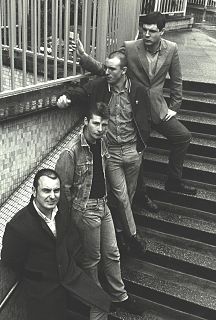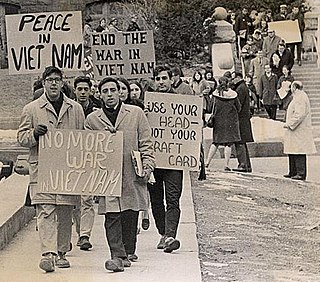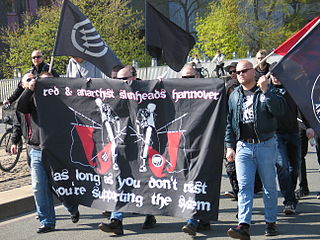Related Research Articles

A skinhead is a member of a subculture which originated among working class youths in London, England, in the 1960s and soon spread to other parts of the United Kingdom, with a second working class skinhead movement emerging worldwide in the late 1970s. Motivated by social alienation and working class solidarity, skinheads are defined by their close-cropped or shaven heads and working-class clothing such as Dr. Martens and steel toe work boots, braces, high rise and varying length straight-leg jeans, and button-down collar shirts, usually slim fitting in check or plain. The movement reached a peak at the end of the 1960s, experienced a revival in the 1980s, and, since then, has endured in multiple contexts worldwide.

Punk fashion is the clothing, hairstyles, cosmetics, jewellery, and body modifications of the punk counterculture. Punk fashion varies widely, ranging from Vivienne Westwood designs to styles modeled on bands like The Exploited to the dressed-down look of North American hardcore. The distinct social dress of other subcultures and art movements, including glam rock, skinheads, rude boys, greasers, and mods have influenced punk fashion. Punk fashion has likewise influenced the styles of these groups, as well as those of popular culture. Many punks use clothing as a way of making a statement.

A subculture is a group of people within a culture that differentiates itself from the parent culture to which it belongs, often maintaining some of its founding principles. Subcultures develop their own norms and values regarding cultural, political, and sexual matters. Subcultures are part of society while keeping their specific characteristics intact. Examples of subcultures include BDSM, hippies, goths, bikers, skinheads, and hip-hopers. The concept of subcultures was developed in sociology and cultural studies. Subcultures differ from countercultures.

Youth culture refers to the societal norms of children, adolescents, and young adults. Specifically, it comprises the processes and symbolic systems that are shared by the youth demographic and are distinct from those of adults in the community.

Mod is a subculture that began in London and spread throughout Great Britain and elsewhere, eventually influencing fashions and trends in other countries, and continues today on a smaller scale. Focused on music and fashion, the subculture has its roots in a small group of stylish London-based young men in the late 1950s who were termed modernists because they listened to modern jazz. Elements of the mod subculture include fashion ; music ; and motor scooters. In the mid-1960s, the subculture listened to power pop rock groups with mod following, such as The Who and The Small Faces, after the peak Mod era. The original mod scene was associated with amphetamine-fuelled all-night dancing at clubs.

In the arts, bricolage is the construction or creation of a work from a diverse range of things that happen to be available, or a work constructed using mixed media.
The 20th century saw the rise and fall of many subcultures.

In criminology, subcultural theory emerged from the work of the Chicago School on gangs and developed through the symbolic interactionism school into a set of theories arguing that certain groups or subcultures in society have values and attitudes that are conducive to crime and violence. The primary focus is on juvenile delinquency because theorists believe that if this pattern of offending can be understood and controlled, it will break the transition from teenage offender into habitual criminal. Some of the theories are functionalist, assuming that criminal activity is motivated by economic needs, while others posit a social class rationale for deviance.
White power skinheads, also known as racist skinheads and neo-Nazi skinheads, are members of a neo-Nazi, white supremacist and antisemitic offshoot of the skinhead subculture. Many of them are affiliated with white nationalist organizations and some of them are members of prison gangs. The movement emerged in the United Kingdom between the late 1960s and the late 1970s, before spreading across Europe, Russia and North America in the 1980–1990s.
Dick Hebdige is an expatriate British media theorist and sociologist, and a professor of art and media studies at the University of California, Santa Barbara. His work is commonly associated with the study of subcultures, and its resistance against the mainstream of society. His current research interests include media topographies, desert studies, and performative criticism.

In the context of the skinhead subculture, a redskin is a marxist skinhead, who often also subscribe to anarchist views. The term combines the word red, with the word skin, which is short for skinhead. Redskins take a militant anti-fascist and pro-working class stance.
The mod revival was a subculture that started in Scotland in 1978 and later spread to other countries. The mod revival's mainstream popularity was relatively short, although its influence lasted for decades. The mod revival post-dated a Teddy Boy revival, and mod revivalists sometimes clashed with Teddy Boy revivalists, skinhead revivalists, casuals, punks and rival gang members.

The sociology of culture, and the related cultural sociology, concerns the systematic analysis of culture, usually understood as the ensemble of symbolic codes used by a member of a society, as it is manifested in the society. For Georg Simmel, culture referred to "the cultivation of individuals through the agency of external forms which have been objectified in the course of history". Culture in the sociological field is analyzed as the ways of thinking and describing, acting, and the material objects that together shape a group of people's way of life.

A youth subculture is a youth-based subculture with distinct styles, behaviors, and interests. Youth subcultures offer participants an identity outside of that ascribed by social institutions such as family, work, home and school. Youth subcultures that show a systematic hostility to the dominant culture are sometimes described as countercultures.
Paul Willis is a British social scientist known for his work in sociology and cultural studies. Paul Willis' work is widely read in the fields of sociology, anthropology, and education, his work emphasizing consumer culture, socialization, music, and popular culture. He was born in Wolverhampton and received his education at the University of Cambridge and at the University of Birmingham. He worked at Centre for Contemporary Cultural Studies and subsequently at the University of Wolverhampton. He was a Professor of Social/Cultural Ethnography at Keele University. In the autumn of 2010, he left Keele University and is now a professor at Princeton University.
Alternative fashion or Alt fashion is fashion that stands apart from mainstream commercial fashion. Alternative fashion includes the fashions of specific subcultures such as emo, scene, goth subculture, hip hop, cyberpunk, kawaii, cottagecore, goblincore, 70's core, and Lolita fashion; however, it is not limited to these. In general, alternative, or 'alt', fashion does not conform to widely popular style trends of the times that have widespread popularity. It may exhibit itself as a fringe style – extremely attention-grabbing and more artistic than practical – but it can also develop from anti-fashion sentiments that focus on simplistic utilitarian drives.
The Encoding/decoding model of communication was first developed by cultural studies scholar Stuart Hall in 1973. Titled 'Encoding and Decoding in the Television Discourse', Hall's essay offers a theoretical approach of how media messages are produced, disseminated, and interpreted. Hall proposed that audience members can play an active role in decoding messages as they rely on their own social contexts, and might be capable of changing messages themselves through collective action.
White power music is music that promotes white nationalism. It encompasses various music styles, including rock, country, experimental music and folk. Ethnomusicologist Benjamin R. Teitelbaum argues that white power music "can be defined by lyrics that demonize variously conceived non-whites and advocate racial pride and solidarity. Most often, however, insiders conceptualized white power music as the combination of those themes with pounding rhythms and a charging punk or metal-based accompaniment." Genres include Nazi punk, Rock Against Communism, National Socialist black metal, and fashwave.

A scooterboy is a member of one of several scooter-related subcultures of the 1960s and later decades, alongside rude boys, mods and skinheads. The term is sometimes used as a catch-all designation for any scootering enthusiast who does not fall into the latter three categories.
References
- 1 2 3 Hebdige, Dick (1979). Subculture: The Meaning of Style. London: Routledge. ISBN 0415039495.
- 1 2 3 4 5 6 7 8 9 Torode, Brian (November 1981). "Subculture: The Meaning of Style by Dick Hebdige". Contemporary Sociology. 10 (6): 856–857. doi:10.2307/2067284. JSTOR 2067284.
- 1 2 3 4 5 6 Adler, Judith (May 1982). "Subculture: The Meaning of Style by Dick Hebdige". American Journal of Sociology. 87 (6): 1458–1459. doi:10.1086/227629. JSTOR 2779397.
- 1 2 3 4 5 Mattson, Kevin (2001). "Did Punk Matter?: Analyzing the Practices of a Youth Subculture During the 1980s". American Studies. 42 (1): 69–97. JSTOR 40643156.
- 1 2 Leitch, Vincent; Lewis, Mitchell (1994). "Cultural Studies: 2. United States". Johns Hopkins Guide to Literary Theory and Criticism. Johns Hopkins University Press. p. 225. ISBN 9780801880100 . Retrieved 30 October 2012.
- ↑ Jasper, Agnes (2004). "'I am not a goth!': The Unspoken Morale of Authenticity within the Dutch Gothic Subculture". Etnofoor. 17 (1/2): 90–115. JSTOR 25758070.
- ↑ Maira, Sunaina (February 1999). "Identity Dub: The Paradoxes of an Indian American Youth Subculture (New York Mix)". Cultural Anthropology. 14 (1): 29–60. doi:10.1525/can.1999.14.1.29. JSTOR 656528.